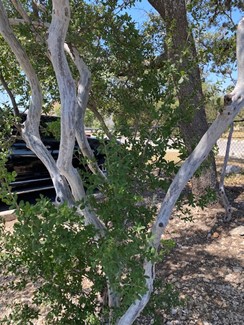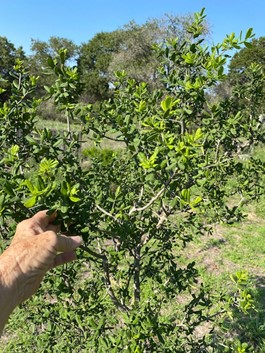By Deva Brown, Bexar County Master Gardener

The Texas persimmon is a shrub, small tree, or understory tree found in northern Mexico and Central and West Texas. There are at least three varieties grown in Texas: the introduced Oriental persimmon (Diospyros kaki),the American persimmon (Diospyros virginiana), and the Texas persimmon (Diospyros texanais).
The Texas persimmon prefers rocky, dry conditions and is known for its peeling bark, often revealing shades of white, gray, and even pink on the trunk. While the Texas persimmon can grow up to 35 feet, it is typically about 10 feet high.
Of note, the national and state champion Texas persimmon tree is located in Uvalde county; the tree is 26 feet tall, is 22 inches in diameter, and provides shade over an area that is 31 feet across!

The trees begin to flower in March or April and the female tree produces small, dark purple fruit (3/4 inches in size). The fruit is very acerbic until it ripens, at which point the taste has been compared to a prune.
The fruit has many practical applications. It has been used to make black hair dye and a dye for leather. But beware; the fruit can also dye the skin! Historically, the fruit has also had medicinal purposes. The Cherokee reportedly chewed the bark to treat heartburnand used the fruit as an astringent for treating sores in the throat and mouth and as a treatment for hemorrhoids.
Even the tough, dark heart wood has practical uses, primarily for tool handles and digging sticks.

I have loved Texas persimmon trees since junior school, where the one in our new backyard would drop overripe, fermented fruit on the ground to the delight of wasps, which would eventually fly off in a ragged, staggering path.
About four years ago, I bought a small Texas persimmon tree and planted it in my backyard. It is rather stunted, having survived the onslaught of leaf cutter ants more than once.

Imagine my delight to discover flowers and small developing fruits for the first time on my tree. Since the Texas persimmon is dioecious (it has separate male and female plants), there must be a male tree somewhere in the vicinity that has fertilized my female tree!
For more information about the Texas persimmon tree, consult these websites:
https://www.texasbeyondhistory.net/st-plains/nature/images/persimmon.html
https://aggie-horticulture.tamu.edu/fruit-nut/files/2015/04/persimmons_2015.pdf
https://www.backyardnature.net/n/w/tex-pers.htm
All photos by author.
